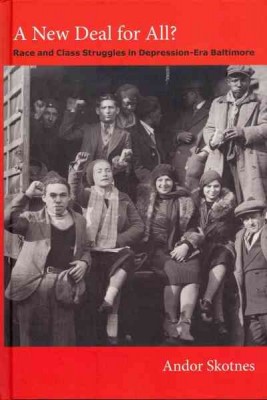| A New Deal for All?: Race and Class Struggles in Depression-Era Baltimore Contributor(s): Skotnes, Andor (Author) |
|
 |
ISBN: 0822353474 ISBN-13: 9780822353478 Publisher: Duke University Press OUR PRICE: $109.20 Product Type: Hardcover - Other Formats Published: December 2012 |
| Additional Information |
| BISAC Categories: - History | United States - State & Local - Middle Atlantic (dc, De, Md, Nj, Ny, Pa) - Social Science | Ethnic Studies - African American Studies - Political Science | Labor & Industrial Relations |
| Dewey: 305.800 |
| LCCN: 2012011609 |
| Series: Radical Perspectives |
| Physical Information: 1.1" H x 6.4" W x 9.2" (1.50 lbs) 392 pages |
| Themes: - Ethnic Orientation - African American - Chronological Period - 1930's - Chronological Period - 1940's - Locality - Baltimore, Maryland - Geographic Orientation - Maryland - Topical - Black History - Ethnic Orientation - Multicultural |
| Descriptions, Reviews, Etc. |
| Publisher Description: In A New Deal for All? Andor Skotnes examines the interrelationships between the Black freedom movement and the workers' movement in Baltimore and Maryland during the Great Depression and the early years of the Second World War. Adding to the growing body of scholarship on the long civil rights struggle, he argues that such "border state" movements helped resuscitate and transform the national freedom and labor struggles. In the wake of the Great Crash of 1929, the freedom and workers' movements had to rebuild themselves, often in new forms. In the early 1930s, deepening commitments to antiracism led Communists and Socialists in Baltimore to launch racially integrated initiatives for workers' rights, the unemployed, and social justice. An organization of radicalized African American youth, the City-Wide Young People's Forum, emerged in the Black community and became involved in mass educational, anti-lynching, and Buy Where You Can Work campaigns, often in multiracial alliances with other progressives. During the later 1930s, the movements of Baltimore merged into new and renewed national organizations, especially the CIO and the NAACP, and built mass regional struggles. While this collaboration declined after the war, Skotnes shows that the earlier cooperative efforts greatly shaped national freedom campaigns to come--including the civil rights movement. |